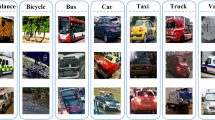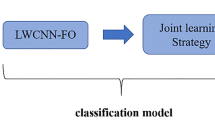Abstract
With the acceleration of economic globalization and integration, the global trade is becoming more frequent, which promotes the vigorous development of transportation industry. In recent years, the Internet of Vehicle (IoV) has developed rapidly in the transportation industry, and the number of IoV users has exploded. The requirements for IoV communication services are very high, resulting in the lack of spectrum resources. Rather than utilizing traditional spectrum resource allocation methods, cognitive radio technology makes full use of idle frequency bands, improving the IoV communication spectrum’s utilization rate. Spectrum sensing is the primary link to realize a cognitive radio. However, IoV mobile communication environment is characterized by complexity, dynamism, and substantial noise interference, thus imposing significant challenges to spectrum sensing. Thus, this paper proposes an intelligent spectrum sensing algorithm based on kernel principal component analysis (KPCA) and an improved convolutional neural network (CNN). Since the wireless signal cannot distinguish the signal and noise linearly, KPCA maps the sampled signal to a high-dimensional space, creates a covariance matrix, and obtains eigenvector data of the signal and noise through matrix decomposition. A spectrum sensing classifier based on improved CNN is proposed, and the dynamic threshold is obtained via offline training. Compared with the traditional algorithm, the designed deep CNN improves the model’s training speed, enables parameter sharing, and reduces the number of model parameters, effectively reducing the computational complexity. Additionally, due to the extracted signal feature’s small dimension, the algorithm reduces the number of pooling layers and avoids the effective features’ loss, thus increasing the detection probability. Finally, the proposed algorithm achieves a 10% higher sensing accuracy than support vector machine (SVM), Elman, and LeNet5 algorithms, signaling its robustness.














Similar content being viewed by others
Data availability
Not applicable.
References
Singh PK, Singh R, Nandi SK, Ghafoor KZ, Rawat DB, Nandi S (2021) Blockchain-based adaptive trust management in Internet of Vehicles using smart contract. IEEE Trans Intell Transp Syst 22(6):3616–3630
Kim Y, Lee TJ (2019) V2IoT communication systems for road safety. IEEE Wirel Commun Lett 8(5):1460–1463
Hisham A, Yuan D, Ström EG, Brännström F (2021) Adjacent channel interference aware joint scheduling and power control for V2V broadcast communication. IEEE Trans Intell Transp Syst 22(1):443–456
Liu R, Yu G, Yuan J, Li GY (2021) Resource management for millimeter-wave ultra-reliable and low-latency communications. IEEE Trans Commun 69(2):1094–1108
Tashman DH, Hamouda W (2021) An overview and future directions on physical-layer security for cognitive radio networks. IEEE Network 35(3):205–211
Hasan C, Marina MK (2019) Communication-free inter-operator interference management in shared spectrum small cell networks. IEEE Trans Cognit Commun Netw 5(3):661–677
Pei E, Zhou L, Deng BG, Lu X, Li Y, Zhang ZZ (2021) A Q-learning based energy threshold optimization algorithm in LAA networks. IEEE Trans Veh Technol 70(7):7037–7049
Liu X, Sun Q, Lu W, Wu C, Ding H (2020) Big-data-based intelligent spectrum sensing for heterogeneous spectrum communications in 5G. IEEE Wirel Commun 27(5):67–73
Lee S, Park SR, Kim YH, Song I (2021) Spectrum sensing for cognitive radio network with multiple receive antennas under impulsive noise environments. J Commun Netw 23(3):171–179
Gharib A, Ejaz W, Ibnkahla M (2021) Distributed spectrum sensing for IoT networks: architecture, challenges, and learning. IEEE Internet Things 4(2):66–73
Zhang S, Wang Y, Zhang Y, Wan P, Zhuang J (2022) Riemannian distance-based fast K-Medoids clustering algorithm for cooperative spectrum sensing. IEEE Syst J 16(1):880–890
Shi Z, Gao W, Zhang S, Liu J, Kato N (2020) Machine learning-enabled cooperative spectrum sensing for non-orthogonal multiple access. IEEE Trans Wirel Commun 19(9):5692–5702
Xu Y, Cheng P, Chen Z, Li Y, Vucetic B (2018) Mobile collaborative spectrum sensing for heterogeneous networks: a Bayesian machine learning approach. IEEE Trans Signal Process 66(21):5634–5647
Zerhouni K, Amhoud EM, Chafii M (2021) Filtered multicarrier waveforms classification: a deep learning-based Approach. IEEE Access 9:69426–69438
Cao WG, Zhang JN, Cai CX, Chen Q, Zhao Y, Lou Y, Jiang W, Gui G (2021) CNN-based intelligent safety surveillance in green IoT applications. China Commun 18(1):108–119
Xu LW, Zhou XP, Tao Y, Liu L, Yu X, Kumar N (2022) Intelligent security performance prediction for IoT-enabled healthcare networks using improved CNN. IEEE Trans Ind Inform 18(3):2063–2074
Fang J, Wang B, Li H, Liang YC (2021) Recent advances on sub-nyquist sampling-based wideband spectrum sensing. IEEE Wirel Commun 28(3):115–121
Qin ZJ, Li GY (2020) Pathway to intelligent radio. IEEE Wirel Commun 27(1):9–15
Liu X, Lin B, Zhou M, Jia M (2021) NOMA-based cognitive spectrum access for 5G-enabled Internet of Things. IEEE Netw 35(5):290–297
Shruti S, Rakhee R (2021) Analysis of spectrum sensing and spectrum access in cognitive radio networks with heterogeneous traffic and p-Retry Buffering. IEEE Trans Mob Comput 21(7):2318–2331. https://doi.org/10.1109/TMC.2020.3042836
**ao Z, Shen XY, Zeng FZ, Havyarimana V, Wang D, Chen WW, Li KQ (2018) Spectrum resource sharing in heterogeneous vehicular networks: a noncooperative game-theoretic approach with correlated equilibrium. IEEE Trans Veh Technol 67(10):9449–9458
Hamedani K, Liu L, Yi Y (2021) Energy efficient MIMO-OFDM spectrum sensing using deep stacked spiking delayed feedback reservoir computing. IEEE Trans Green Commun Netw 5(1):484–496
Joshi H, Darak SJ, Kumar AA, Kumar R (2019) Throughput optimized non-contiguous wideband spectrum sensing via online learning and sub-Nyquist sampling. IEEE Wirel Commun Lett 8(3):805–808
Gu Y, Pei Q, Li H (2019) Dynamic matching-based spectrum detection in cognitive radio networks. China Commun 16(4):47–58
Javaid N, Sher A, Nasir H, Guizani N (2018) Intelligence in IoT-Based 5G networks: opportunities and challenges. IEEE Commun Mag 56(10):94–100
Shi S et al (2021) Challenges and new directions in securing spectrum access systems. IEEE Internet Things J 8(8):6498–6518
Wang J, Zhang B, Jia L, Zhao B, Guo D (2020) A distributed collaborative game-theoretic approach in cognitive satellite communication networks. IEEE Access 8:129446–129460
Wang D, Qi P, Fu Q, Zhang N, Li Z (2021) Multiple high-order cumulants-based spectrum sensing in full-duplex-enabled cognitive IoT networks. IEEE Internet Things J 8(11):9330–9343
Liu X, Sun C, Zhou M, Lin B, Lim Y (2021) Reinforcement learning based dynamic spectrum access in cognitive Internet of Vehicles. China Commun 18(7):58–68
Xu W, Wang S, Yan S, He J (2019) An efficient wideband spectrum sensing algorithm for unmanned aerial vehicle communication networks. IEEE Internet Things J 6(2):1768–1780
Zhou X, Sun M, Li GY, Juang BHF (2018) Intelligent wireless communications enabled by cognitive radio and machine learning. China Commun 15(12):16–48
Khalek NA, Hamouda W (2021) From cognitive to intelligent secondary cooperative networks for the future internet: design, advances, and challenges. IEEE Network 35(3):168–175
Yang H, **e X, Kadoch M (2020) Machine learning techniques and a case study for intelligent wireless networks. IEEE Network 34(3):208–215
Mollah MB, Zhao J, Niyato D, Guan YL, Yuen C, Sun S, Lam KY, Koh LH (2021) Blockchain for the Internet of Vehicles towards intelligent transportation systems: a survey. IEEE Internet Things J 8(6):4157–4185
Rathee G, Ahmad F, Kurugollu F, Azad MA, Iqbal R, Imran M (2021) CRT-BIoV: a cognitive radio technique for blockchain-enabled Internet of Vehicles. IEEE Trans Intell Transp Syst 22(7):4005–4015
Funding
This research was supported by the National Natural Science Foundation of China (No. 62201313), the Open Project of Fujian Key Laboratory of Spatial Information Perception and Intelligent Processing (Yango University)(No.FKLSIPIP1009), and the Open Project Program of Fujian Key Laboratory of Big Data Application and Intellectualization for Tea Industry, Wuyi University(No.FKLBDAITI202206).
Author information
Authors and Affiliations
Contributions
Yanyan Duan: Development of methodology; creation of models; designing computer programs; Validation;
Fenghua Huang: Writing—Review & Editing, Supervision, Funding acquisition, reviewed the manuscript;
Lingwei Xu: Conceptualization, Writing—Review & Editing, Supervision, Funding acquisition, reviewed the manuscript, formal analysis;
T. Aaron Gulliver: Writing—Review & Editing, reviewed the manuscript.
Corresponding authors
Ethics declarations
Ethical approval
Not applicable.
Consent to publication
All authors have read and agreed to the published version of the manuscript.
Conflict of interest
The authors declared that there is no conflict of interest.
Additional information
Publisher's Note
Springer Nature remains neutral with regard to jurisdictional claims in published maps and institutional affiliations.
Rights and permissions
Springer Nature or its licensor (e.g. a society or other partner) holds exclusive rights to this article under a publishing agreement with the author(s) or other rightsholder(s); author self-archiving of the accepted manuscript version of this article is solely governed by the terms of such publishing agreement and applicable law.
About this article
Cite this article
Duan, Y., Huang, F., Xu, L. et al. Intelligent spectrum sensing algorithm for cognitive internet of vehicles based on KPCA and improved CNN. Peer-to-Peer Netw. Appl. 16, 2202–2217 (2023). https://doi.org/10.1007/s12083-023-01501-0
Received:
Accepted:
Published:
Issue Date:
DOI: https://doi.org/10.1007/s12083-023-01501-0




